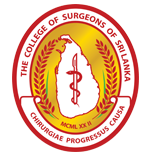Museum
How can we show the various artifacts of Sri Lanka’s surgical history to a global audience? This was the challenge the CSSL set themselves. The result is this virtual museum, which is under construction. It is ‘work in progress’ and no doubt would grow and be modified over time.
It is established to cover few main themes. They include artifacts from Sri Lanka ancient surgical history, images, artifacts and documents relating to the giants in the modern surgical history, memorabilia of the College of Surgeons of Sri Lanka and contemporary surgery images.
The virtual museum has the advantage of global reach as well as continuous access. This would be complemented by a real museum of the CSSL in the future.
Visitors to the virtual museum are invited to walk through each room and view the images by clicking on them. You may skip any room and exit at any time. Should you have any comments, do not hesitate to fill in the feedback form when you exit.
Alahana Privena
“The finds at the Alahana Pirivena ancient hospital complex in Polonnaruwa are unique, for it is the only hospital site from around the world in archaeological terms that a number of surgical instruments have been unearthed in addition to medical equipment. It was a monastic hospital that they discovered in 1982 within the Alahana Pirivena, one of the largest monastic complexes founded by Physician-King Parakrama Bahu I (1153-1186 AD).”
Prof. Prematilleke, formerly Head of the Department of Archaeology of the Peradeniya University and Founder President of the Sri Lanka Council of Archaeologists.
Click to enlarge. Photos courtesy Prof Arjuna Aluvihare
“Metal applicators for applying medications or cosmetics around the eye? Probes- known to have been used to sound cavities and in the delineation of fistulae and sinuses. Large scissors of which there are several examples- of the kind used to cut cloth for bandages and dressings. Smaller scissors- to be fitted with wooden handles- perhaps used for cutting tissue. A lance- a type of instrument used for ‘stabbing’ open tissue very quickly to drain pus from an abscess or cut through the perineum (between the anus and the scrotum) for stones in the urinary bladder. Forceps with very strong jaws as might be used for removing dead bone or extracting teeth. Forceps with more delicate structure that might be used to handle tissue like skin or intestine. A scalpel to be used with a wooden handle.
The weighing scales, lime containers and arecanut cutters are virtually identical with modern equivalents. More important these instruments- particularly the scissors, forceps, lance, and scalpel are almost identical with modern instruments. There are texts of Susrutha and Charaka which describe old instruments and the operations done at that time before and just after the beginning of the Christian era. Finding instruments at Polonnaruwa is a very great significance as it indicates that operations were actually done- and not just imagined.”
Prof Arjuna Aluvihare, Emeritus Professor, University of Peradeniya.
P R Anthonis
“He was the Founder President of The College of Surgeons of Sri Lanka in 1974. He was President of the Sri Lanka Medical Association in 1967. He served as Chancellor of the University for a record 25 Obituary period of 21 years.”
” It is difficult for the modern doctor to understand the ability and skills and achievements of medical practitioners of the era of Dr. Anthonis. He passed out as a doctor in 1936 when the pharmacopoeia consisted of lotions, powders and mixtures. Antibiotics were unknown (Penicillin was discovered two years after he went to UK to train as a surgeon). Intravenous anaesthesia was discovered only just (Chloroform was discovered in 1864).”
“…he was meticulous in keeping notes on every operation he carried out whether it was big or small, in a large register. Most of his operations were graphically illustrated with beautiful diagrams with footnotes explaining the significance. Some of these registers will be gifted to medical libraries by his son, Lal.”
Sheriffdeen, A., (2011). Deshamanya Dr. P. R. Anthonis. Sri Lanka Journal of Surgery. 28(1), pp.23–26. DOI: http://doi.org/10.4038/sljs.v28i1.3052




